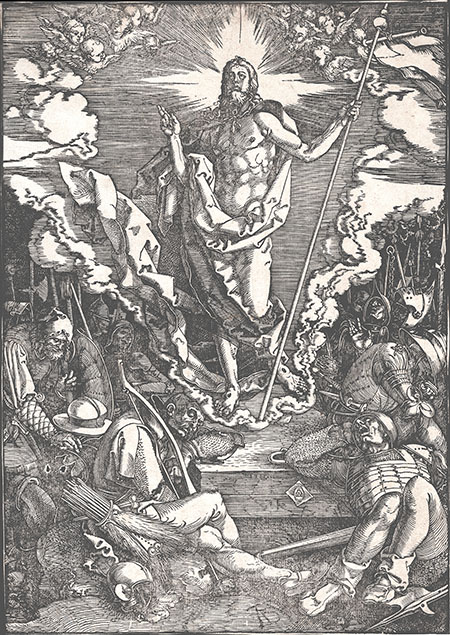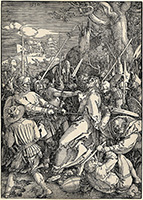(Nurnberg 1471 - 1528)
THE RESURRECTION, 1510
Woodcut, 1510, from the Large Passion. A good, strong impression in black ink after the text edition of 1511 with partial, indistinct watermark, at bottom. Bartsch 15, Meder 124, Strauss 151.
According to Meder, our copy can be described as an a/d edition after the text, as the woodworm hole in the mantle, near the right knee of Christ, does not yet appear. A few defects, clearly visible only on the verso; a central horizontal crease and a couple of tiny tears and thinnings in the paper. 392 x 278 mm.
Generally regarded as the greatest German Renaissance artist, Dürer initially trained in Nüremberg as a goldsmith, painter, and woodcutter. After visiting Venice in 1495, he studied mathematics, geometry, Latin, and humanist literature. He expressed himself primarily through prints; painting being less profitable, and Lutheran church reformers disdained most religious artworks. Dürer's paintings are few and more traditional than his engravings and woodcuts. In 1498 he published the first book entirely produced by an artist, The Apocalypse, which included fourteen woodcuts illustrating the Book of Revelation. Its vivid imagery, masterly draftsmanship, and complex iconography established his reputation. After visiting Italy again from 1505 to 1507, Dürer's art assimilated Renaissance principles. Unlike his earlier, more Gothic woodcuts, Dürer's engravings of 1513 and 1514 suggest the influence of Italian chiaroscuro and were conceived in painterly terms, using a range of velvety tones rather than lines. Despite the impressive scope of his workshop, Dürer left no direct successors, though his easily transportable prints were influential throughout Europe.

